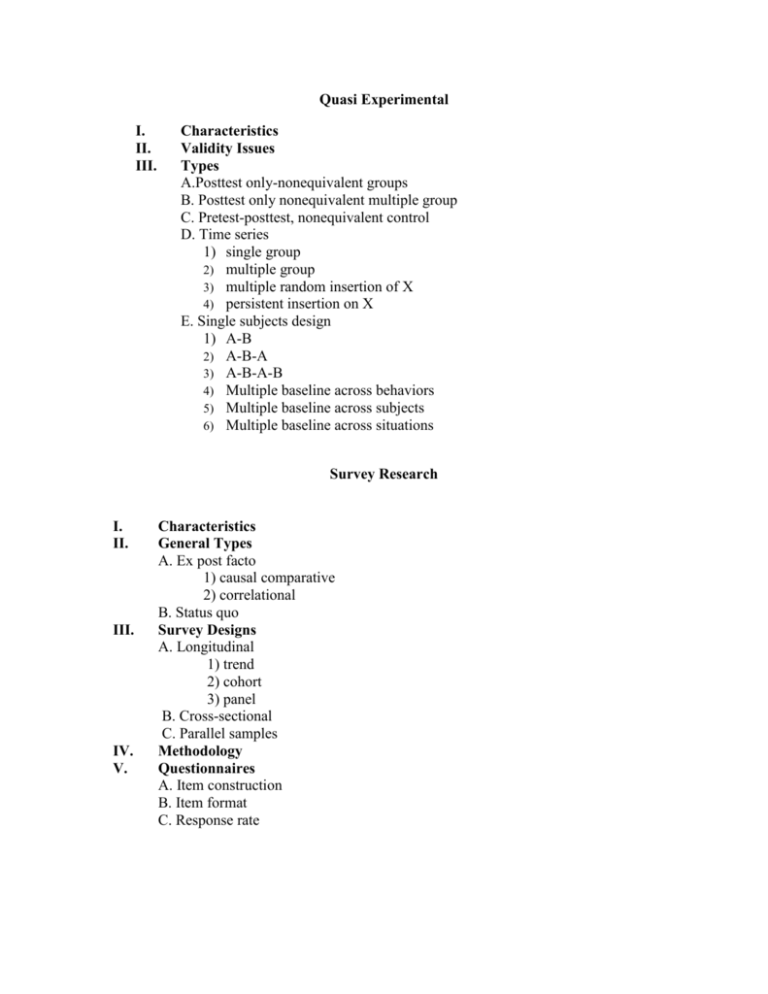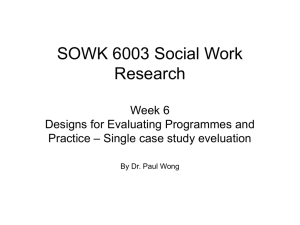Survey designs
advertisement

Quasi Experimental I. II. III. Characteristics Validity Issues Types A.Posttest only-nonequivalent groups B. Posttest only nonequivalent multiple group C. Pretest-posttest, nonequivalent control D. Time series 1) single group 2) multiple group 3) multiple random insertion of X 4) persistent insertion on X E. Single subjects design 1) A-B 2) A-B-A 3) A-B-A-B 4) Multiple baseline across behaviors 5) Multiple baseline across subjects 6) Multiple baseline across situations Survey Research I. II. III. IV. V. Characteristics General Types A. Ex post facto 1) causal comparative 2) correlational B. Status quo Survey Designs A. Longitudinal 1) trend 2) cohort 3) panel B. Cross-sectional C. Parallel samples Methodology Questionnaires A. Item construction B. Item format C. Response rate Quasi-experimental Research Characteristics- involves use of intact groups along with manipulation of an experimental variable. Validity issues- lack of random assignment contributes to problems with internal and external validity. Non-equivalent groups cause problems with interpretation. Selection bias causes problems with generalizability. Types 1)Posttest-Only, nonequivalent control group design. Weakest of designs. No way to argue similarity of groups prior to treatment. 2)Posttest-only nonequivalent multiple groups design (no control group) 3)Pretest-posttest, Nonequivalent Control group design. Adding pretest aids in checking similarity of groups prior to treatment. Pretest scores can be used for statistical control (as a covariate) 4)Time series designs- repeated measures of one or more intact groups with experimental treatment randomly inserted between two of the measurements of at least one group. Numerous observations provide way for locating effect. May have some of the same concerns that repeated measures designs have. a)Single group time series b)Multiple group time series- stronger design because it provides a means of comparison- enhances internal validity. Observations prior to treatment can aid in comparing similarity of groups prior to treatment. c)Multiple random insertion of X d) Persistent insertion of X 5) Single-subject design- study of the individual under experimental and nonexperimental conditions. Usually involve repeated measurements. Characterized by single variable rule- only one variable is cnaged during the period in which the experimental treatment is applied (increases internal validity- interpretation of results.) Have constant periods of time and numbers of observations during the baseline or treatment periods. Baseline- period during which normal condition is in effect. Needs to be long enough for the dependent variable to stabilize. A-B design- baseline, treatment- assumption that the observations would not have changed from those of the baseline condition if the experimental treatment had not been introduced. Susceptible to validity issues (internal- maturation and history) A-B-A design- baseline, treatment, baseline. Experimental treatment is withdrawn A-B-A-B design- two cycles of baseline and experimental periods. Multiple baseline design across behaviors-behaviors must be independent. Single subject observed in same situation on two or more behaviors. (Example-use of verbal prompting or cueing for appropriate behaviors) Multiple baseline design across subjects-use of two or more subjects. Subjects must be independent of each other in terms of the experimental treatment (Example- use of verbal prompting would not be a good idea, both hear the prompt and may respond). Could use if in different classes. Multiple baseline design across situations- involves same subject, same behavior in different situations. Survey research Characteristics- less control than in experimental research. Natural setting with numerous variables operating simultaneously.. Widely used in education. General types of survey research- ex post facto (causal-comparative or correlational) or status quo ( determines condition of some variable, situation or context) Ex post facto- variables are studied in retrospect to determine relationships and effects. No deliberate manipulation of variables. Studies are of conditions or situations as they are found. Causal-comparative- examines effects between variables in nonexperimental setting (Carr and Jessup study). Correlational- examines relationships between variables. Does not attempt to make causal statements or inferences. Survey designs Longitudinal- collection of data over time and at specified points in time. Useful in measuring change and status over time. Trend study-general pop. Is studied over time. Pop is randomly sampled and samples are then measured. EXAMPLE –all the studies on “Adolescents” Cohort study- Longitudinal study of a specific population. Random samples are taken from the specific population and measured. “Class of 2000” Trend and Cohort allow researcher to study change or status over time with a Group focus. Panel study- Longitudianl study in which the same sample is measured tow or more times. Sample may be specific or general population. (Class of 2000 in Gwinnett County) My nursing study. Allows for measure of change but also to identify where or with whom change is occuring. Useful in establishing a case for “cause and effect” Cross-sectional- collection of data at one point in time from random sample representing some given population at that time. Cannot be used to measure change in individualonly measured once. But, differences between groups may represent differences or changes in a larger population. Parallel-samples design-selecting samples from two or more populations simultaneously and conducting a study related to same research problem. Methodology Planning-Define problem and begin survey design. Involves review of lit., operational definition of variables and exploring relationships to other variables or phenomenon. Develop sampling plan (more discussion next chapter) Construct instruments and determine type of data to be collected and methods of analysis. Prepare initial draft and pilot test. Use similar population. 5-10 people is good, no more than 25. Check for ambiguity, confusion and poorly prepared items. Prepare final instrument Collect data following previously designed sampling plan. Consider and plan for ways to check for Interrater reliability, intrarater reliability. Conduct follow ups Translate data- prepare it for analysis, coding, categorizing, etc. Analysis- individual and group analysis. Synthesis of results Conclusions and reporting. Questionnaires- much effort is spent constructing good items and getting respondents to complete the questionnaires. Guidelines for good test writing apply to good questionnaire writing as well. Item format Selected response- forced choice Open-ended response Advantages/disadvantages of each Special example of selected response- Likert scale Questionnaire Format Include cover letter. Group like items together. Demographic items should be at end. Not too long!!!! Response rate- (make sure you have some way of knowing who has and has not returned the questionnaire) Validity of survey research depends on response rate and quality of responses. Nonresponse may bias the results. Prof. Pop…..70% is minimum acceptable. Shoot for this at least. Methods to increase- precontact, monetary rewards or gratuity, follow ups. Nonresponse- (Either not returning or not answering particular items) try to identify reasons. Look for patterns. DO NOT assume that nonresponse is randomly distributed throughout the sample. Incomplete, dishonest responsesBuild into questionnaire ways to check for honesty 1. Impossible response 2. Implausible frequency or extent of use 3. Unlikely response combinations- use of multiple items for same question. 4. Honesty item- ask them to rate their honesty.






